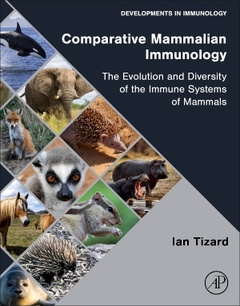Comparative Mammalian Immunology The Evolution and Diversity of the Immune Systems of Mammals Developments in Immunology Series
Auteur : Tizard Ian R

Comparative Mammalian Immunology: The Evolution and Diversity of the Immune Systems of Mammals provides a review on the current knowledge of mammalian immune systems from a comparative viewpoint. This reference encompasses recent work on the immune systems of marine mammals, bats and marsupials in addition to other lesser-known species, with the immune systems of humans and laboratory mice as components of chapters on primates and rodents respectively. The book also makes use of the most recent studies on the genomic sequences of the mammals to identify both common and unique features of each mammal's immune system.
The book elucidates the complex, but coordinated and controlled series of interactions involving cells and molecules that has evolved to protect the host against disease. Mammals consist of a highly diverse group of animals in which the immune system has been subjected to a variety of selective pressures. This is reflected in differences in the organization and function of their immune systems, and is especially seen in those gene families characterized by complexity and polymorphism.
SECTION 2: MAMMALIAN ORDERS 11. Monotremes: Echidnas and platypus 12. Marsupials: Koalas and kangaroos 13. Placentals: Cetartiodactyla: camels and llamas 14. Cetartiodactyla: Pigs and peccaries 15. Ruminants: Cattle, and sheep 16. Cetaceans: Dolphins and whales 17. Chiropterans: Bats 18. Carnivora 19. Perissodactyls: Horses 20. Lagomorphs: Rabbits 21. Rodents: Rats and mice 22. Primates: Monkeys, apes, and humans 23. Paenungulates: Elephants and sirenians 24. Xenarthrans: Sloths and anteaters 25. Synthesis
- Demonstrates multiple diverse pathways and mechanisms to optimize resistance and survival in the face of infectious diseases
- Shows the clear patterns of emergence of different immunologic traits among the diverse orders of mammals
- Reflects issues with innate or adaptive immune systems
- Serves as a comprehensive review of the current state of knowledge of the immune system of each mammalian order
Date de parution : 02-2023
Ouvrage de 458 p.
19x23.4 cm
Thème de Comparative Mammalian Immunology :
Mots-clés :
Mammals; Immune system; Evolution; Immunity; Microbiota; Infectious Disease; Lymphoid organs; T cells; B cells; Immunoglobulins; ?Aardvarks; Adenosine triphosphate; Aggregated lymphoid nodules; Aging; Alpacas; Altricial; Ameridelphian; Amniotes; Anal tonsil; Anteaters; Antigen binding; Antigen receptor; Antimicrobial peptides; Appendix; Armadillos; Australadelphian; B cells; Bears; Blocking antibodies; Body size; Body temperature; Bone marrow; Breeds; CCL16; Camels; Cathelicidins; Cats; Cell-mediated immunity; Chimpanzees; Class I; Class II; Class III; Colostrum; Commensal microbiota; Commensals; Complement; Complementarity determining regions; Conglutinin; Constant regions; Coronaviruses; Coypu; DAMPs; Defensins; Dogs; Dromedary hemolymph nodes; ELA system; Eggs; Elephants; Endothermy; Equinins; Eutheria; Fetal tolerance; Foregut fermenters; Gamma/delta T cells; Gamma/delta high species; Gamma/delta low species; Gerbils; Germinal centers; Goats; Gorillas; Guinea pigs; H-2 system; Hamsters; Hare; Heavy chains; Heavy-chain only antibodies; Helper T cell; Heterozygote advantage; Hibernation; Hindgut fermenters; Homeothermy; Horse; Hyaenas; Hypothermia; Hyraxes tenrecs; IgA; IgA subclasses; IgD; IgE; IgG; IgG subclasses; IgM; IgO; Immune regulation; Immunoglobulin A; Immunoglobulin D; Immunoglobulin G; Immunoglobulins; Inflammasomes; Inflammation; Innate immunity; Innate lymphoid cells; Interferons; Interleukins; Intestinal mucosa; K strategists; K strategy; K-Pg event; KIRs; Kidney



